Carl Linnaeus
Carl Linnaeus, or Carl von Linné as he later was called, was born on the 13 of May 1707 at Råshult in the parish of Stenbrohult in Småland, Sweden.
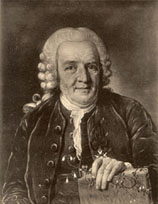
His parents were Nils Linnaeus and Christina Brodersonia. Two years after his birth, the family moved to Stenbrohult when his father became a parish priest after his father in law, Samuel Brodersonius, had died.
Carl later got four siblings, Anna Maria, Sophia Juliana, Samuel, who later succeeded his father as a parish priest in Stenbrohult, and Emerentia.
Interested in botany
Nils Linnaeus was a devoted amateur botanist and gardener. His enthusiasm was infectious on the young Carl who early in life becomes interested in botany and at the age of 5 got his own garden to take care of. In 1717 Carl began school in Växjö.
His parents had early decided that their son should, like his father, become a priest. Carl was not interested, he preferred to spend his time in the nature. In school therefor he was called "little botanicus". He was not successful in school and the teachers advised Nils against to let his son become a priest. After advise from the teacher in natural science, Dr. Rothman, Carl instead got permission to study medicine.
Studies
In 1727 Carl moved to Lund for medicine studies. In Lund he could wholeheartedly devote himself to medicine and natural history. He wrote in one of his autobiographies that it then became as fun to study as it earlier had been unpleasant. Carl stayed only one year in Lund before he, again after advice from Dr. Rothman, moved to Uppsala.
In 1728 Carl was enrolled at the faculty of medicine at the University of Uppsala. As a student without means Carl soon got influential friends. In the botanical garden in Uppsala Carl met the dean in Uppsala, Olof Celsius, who was very interested in botany. Celsius helped Carl financially and for a while Carl stayed in Celsius house before he moved to professor Olof Rudbeck fil. to work as a teacher for Rudbeck's three sons.
Lecture in botany
Professor Olof Rudbeck fil. cared for Carl, made it possible for him to get a scholarship, and when Rudbeck needed to leave his job because of age he commissioned Carl to give lectures in botany in the botanical garden. As a botanical demonstrator Carl renewed the badly looked after botanical garden and introduced new, rare plants. He also began to teach botanical theory, which was something completely new. He developed his thoughts in this subject and published them in 1751 in Philosophia botanica.
Linnaeus stayed only a short time as a botanical demonstrator. When the medicine student Nils Rosén returned from a journey in 1731 he was commissioned to substitute for Rudbeck instead of Linnaeus. Carl decided in the end of 1731 to leave the Rudbeck family and for a while he went back to his parents in Småland.
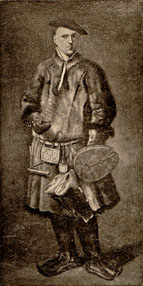
Journeys to Lappland
After an application to the Royal Science Society in Uppsala, Linnaeus got a grant for a scientific journey to Lappland in norhern Sweden. Linnaeus had a long time nourished a wish to see Lappland and Rudbeck probably had enticed him by telling him about his own journey to Torne lappmark.
When a fire in Uppsala destroyed the natural history specimens Rudbeck collected in 1702, Lappland was from a natural history point of view, still unknown. On the 12th of May 1732 Linnaeus alone rode towards the north and five months later, on the 10th of October, he was back in Uppsala.
Flora Lapponica
The story about Linnaeus' journey attracted attention, not only in Uppsala, but also outside the country. Linnaeus account of the journey was extensive. He did not only make observations about nature he was also interested in the Sami culture. His major effort however was the botanical descriptions. In his Flora Lapponica he described the vegetation of an almost unknown part of Sweden.
After his tour to Lappland, Carl was broke because he had to pay parts of his journey himself. To earn his living he gave lectures, for example in ore and mineral analysis, which he had learnt during his trip to Lappland. In the autumn 1733, when he had saved enough money, he went to Falun in Dalarna for further studies in mineralogy.
Linnaeus stayed on for a while with the county governor Reuterholm in Falun to finish of his account of the journey, Iter Dalecarlicum. In Falun Linnaeus also got to know the Moræus family. The father Johan Moræus was a physician in Falun. In February 1735 Linnaeus proposed to Moræus' daughter Sara Elisabeth Moræa. As a condition for the marriage Moræus demanded Linnaeus to travel abroad to pass his MD to make it possible to financially support a family.
The journey abroad
The father of Linnaeus' friend Claes Sohlberg promised Carl to pay him an annual compensation if he accepted to be his sons tutor and bring him on his journey abroad. Carl accepted the proposal and he and Claes Sohlberg started their journey in February 20, 1735.
They traveled via Hamburg and in May 5 they reached Harderwijk in the Netherlands. The University of Hardevijk was famous for issuing quick examinations. In May 9, a few days after his arrival, Linnaeus got his MD. He defended a thesis about malaria where he connected the disease with the amount of clay in the water.
Leiden
Linnaeus had thought of returning to Sweden, but since he had run out of money, he instead followed his friend Sohlberg to Leiden. In Leiden Linnaeus succeeded, as he used to do, to become acquainted with several rich, botanically interested persons who supported him financially.
The senator of Leiden, Dr. Johan Fredrich Gronovius, paid for the publication of Linnaeus' Systema naturae. Professor Herman Boerhaave, one of his time's biggest authorities in medicine, offered Linnaeus, on his expense, to travel to South Africa for two years to collect plants for the botanical garden in Leiden and thereafter continuing his journey to America. Linnaeus declined the offer, as he wanted to return to his Sara Lisa back in Sweden, as soon as possible.
Proceeded to Amsterdam
Linnaeus decided to leave Leiden and proceeded to Amsterdam. In Amsterdam he met Professor Johan Burman, the superintendent of the botanical garden in Amsterdam. Burman offered Linnaeus food and accommodation if he helped him work up the plants from Ceylon that Burman was working with. Linnaeus stayed over the winter and during his stay he also published Bibliotheca Botanica and Fundamenta Botanica.
The reputation of Linnaeus competence and knowledge in botany was spread in the Netherlands. In the autumn 1735, the director of the Dutch East India Company Georg Clifford, persuaded Linnaeus to start working for him in his botanical garden. Linnaeus accepted the offer and stayed with Clifford. During his stay, Linnaeus did not lack anything. Linnaeus used the time efficiently and travelled to the botanical gardens in Holland to obtain plants for Clifford's garden. He also published Genera plantarum and Flora Lapponica.
On Clifford's expense, Linnaeus travelled to England to collect plants for the garden. In Oxford Linnaeus visited the head of Sherard's Botanical Garden, Professor Johan Jacob Dillenius. Dillenius first disagreed with Linnaeus about his newly published Genera plantarum. Dillenius thought that Linnaeus had brought "the whole botany in disorder". Together they carefully examined flowers and after that Linnaeus succeeded to convince Dillenius about the advantages of his new plant genera. They separated as good friends and Linnaeus returned to Holland.
Publications
In 1737, Linnaeus published the book he had worked on during his stay at Clifford, Hortus Cliffortianus. At the same time he "amused" himself by writing Critica Botanica. Because of overstrain Linnaeus became ill and despite the luxury he was surrounded by he began to long for home. In October 7, 1737, Linnaeus left Clifford's garden and travelled towards Paris.
Linnaeus travelled via Leiden on his way to Paris to visit his friends, Professor Adriaan van Royen and Professor Boerhaave. Van Royen succeeded in persuading Linnaeus to stay for six months to arrange his garden. Linnaeus wrote Hortus Leydenensis, published his Classes plantarum and his deceased friend Petri Artedii's Ichthyologica in five volumes.
After some time of illness, shivering and cholera, Linnaeus continued his trip towards Paris. In Paris Linnaeus visited Professor Anton de Jussieu who showed him the gardens and herbaria of Paris. The French Academy of Sciences accepted Linnaeus as a correspondent. He also got another offer of employment but declined. He stayed for a month in Paris before he left for home.
In June 28, 1738, Linnaeus reached Helsingborg in Sweden. After a short visit in his father's house in Småland, Linnaeus continued his journey to Falun and Sara Lisa Moræa. The couple now got a formal engagement. Linnaeus soon left Falun to try to find a job as a physician in Stockholm to make it possible to support a family.
Practicing physician in Stockholm
To begin with, Linnaeus had difficulties in getting a job as a physician in Stockholm. He wrote in one of his autobiographies [translated from Swedish]:
"Stockholm received Linnaeus in the month of September 1738 as a stranger; Linnaeus intended to earn his living as a Doctor here, but since he was unknown to everybody, nobody dared to entrust their dear life in an untried Doctor's hands, not even his dog, thus he often doubted his maintenance in the Country. He, who everywhere abroad was honoured as a Princeps Botanicorum, was at home as a Klimius coming from the world under ground, so if Linnaeus not had been in love, he had infallibly again went away and left Sweden".
Soon everything brightened for Linnaeus. Thanks to his ability to impress important people, he got in touch with the field marshal Count Carl Gustav Tessin. Tessin arranged an employment for Linnaeus at the "Bergs Collegio". During the summers, Linnaeus was supposed to hold lectures about botany and during the winters about minerals. Tessin also influenced Admiral Ankarkrona to offer Linnaeus an employment as an appointed physician at the Admiralty.
During his days in Stockholm Linnaeus was one of the founders of the Swedish Academy of Sciences. The first meeting of the Academy was held in May 1739. The distribution of work was decided by drawing of lots and Linnaeus became the first Praeses of the Academy.
Linnaeus economy had improved that much that he got permission to marry his fiancé Sara Elisabeth Moræa. The wedding was held at Moræus' farm Sveden in Falun in June 26, 1739.
In January 20, 1741, Linnaeus' and Sara Lisa's first child was born, their son Carl. In 1743 their second child was born, their daughter Elisabeth Christina and the year after Sara Magdalena, who died just 15 days old. The couple then got four other children, Lovisa, Sara Christina, Johannes and Sophia. The son Johannes died before his third birthday.
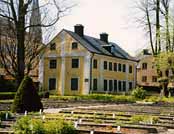
Professor in Uppsala
In the spring 1740, Professor Olof Rudbeck in Uppsala died. After some debate Nils Rosén was appointed as his successor to Linnaeus disadvantage. Rosén had at that time been Rudbeck's substitute for nine years. The other professorship of medicine in Uppsala, possessed by Lars Roberg, also became available when Roberg retired because of age. Linnaeus got this professorship instead and took up his duties in May 5, 1741. Linnaeus and Rosén then changed their chairs. Linnaeus got responsibility for the Botanical Garden, the botany and natural history while Rosén became responsible for the anatomy, fysiology and the other medical professions.
In 1744 Linnaeus was appointed to secretary of the Royal Swedish Society of Sciences in Uppsala. Later in the same year he also became appointed as Inspector at "Smålands nation" in Uppsala. In the summer 1745 Linnaeus published his books Flora Suecica and Fauna Suecica.
In 1747 Linneaus was appointed by the king to Archiater, i. e. senior physician, which was a great mark of respect. In the same year he also, as the only Swede, became a member of the Academy of Sciences in Berlin. Linnaeus later became member of a great number of Academies, i. e. the ones in Russia and France and also the Academy of Sciences in Philadelphia. In 1749 Linnaeus was appointed as principal at the University of Uppsala.
With Linnaeus as professor a period in Uppsala began where the nature science was much esteemed. Linnaeus was a devoted teacher and did not neglect his teaching duties. He did not only draw medical students to his lectures, but also students from other faculties. Students from all over Europe came to Uppsala to become Linnaeus' pupils. Linnaeus himself described this period in this way [translated from Swedish]:
"...att intet Rike i Europa Botaniquen kunde sägas vara i mer flor, ty då han årligen Botanicerade om sommartiden, hade han ett par hundrade auditores som samlade örter ock Insecter, anstälde observationer, skjöto Foglar, förde Protocoll, ock sedan de ifrån morgonen kl. 7 till aftonen kl. 9. Onsdagar ock Lögerdagar Botaniceradt, återkommo de i staden med Blomster i hattarne, samt Pukor ock Waldthorn fölgde sin anförare till Trägården igenom hela Staden. Ock åtskillige, så utländske, som Herrar ifrån Stockholm bevistade Linnaei excursioner."
He had always something to tell about every plant and animal species he found during his walks. It could be something about their ecology, physiology or usage. He often added short anecdotes and funny episodes. When notes were made during these excursions it is possible to get an idea of Linnaeus way of telling. The following anecdote is said to be Linnaeus' story about Annual Knawel, Scleranthus annuus
"Tragus, who was Professor in Leipzig, asked, when he should say the name of this, a Swedish student, who was not a botanist. He answered: "Knäfvelen" knows, which the Professor accepted and gave the herb the name of Knävel. The Dutch, who should print this, left the dots over ä and then it become Knavel.
Among all these students listening to Linnaeus' lectures there was a smaller group of pupils eager to learn, with a great interest in nature, which was called Linnaeus' disciples. Linnaeus always had time and consideration for them. Several of the most poor students got food and accommodation in Linnaeus' home in the same way Linnaeus once was helped by Celsius, Rudbeck, Gronovius and Boerhaave. Many of these disciples, or apostles as Linnaeus called them, travelled to foreign countries to study the fauna and flora in the spirit of Linnaeus.
In 1753 Linnaeus finished his book Species plantarum in two volumes. After all writing and sitting during the intensive work with the books he got pain in his right side. This was cured by his cure-all medicine, wild strawberries.
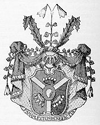
Raised to the nobility
Linnaeus was dubed in 1753 by king Adolph Fredrik to knight of Nordstjärneordern as the first civilian in Sweden. In 1761 he was raised to the nobility and took the name von Linné. Linné drew a proposal on a coat of arms for the noblefamily von Linné.
His proposal was composed of three fields with the colours of the nature; black, green and red. Above these fields was an anatomic egg and in the helmet a Linnaea borealis. The national herald Daniel Tilas rejected his proposal but he later came up with a proposal that was accepted by Linné.
When Linné was released from his duties at the academy in 1763 Linné's son, Carl fil., got the title of professor. Despite this, it was no big difference. Linné continued working as usual. During the 1770's Linné's health became worse and in 1777 he was no longer capable of doing his work and he submitted his resignation. Linné fil. then took over the duties, but he got no salary until his fathers death two years later, in January 10, 1778.
Journeys commissioned by the Government
During his lifetime Linné made several journeys in Sweden commissioned by the Government. In May 15, 1741, he travelled to Öland and Gotland together with six students to look for plants useful for medicine or dyeing. Linné's own description of the journey in one of his biographies says:
"...travelled towards Calmar, at Öland in the Alum mine almost loose his leg, at Blåkulla was in distress at sea, on the way from Gotland was in mortal danger, at the journey home visited his old father and family, was at home at autumn with the commission well performed. "
His observations from the journey he published in 1745 in his Öländska och Gothländska Resa.
In summer 1746 Linné, again commissioned by the Government, travelled to the Swedish province Västergötland. He travelled together with B. S. Erik Gustaf Lidbeck. The mission was the same as during his journey to the islands Öland and Gotland. The journey went through Västergötland to Gothenburg and back home through the provinces Dalsland and Värmland. The year after Linnaeus published his Wästgöta-Resa. After this trip the Government decided Linnaeus should do a similar journey to the province Skåne. The expedition was postponed for some time since Linnaeus thought himself too busy to make the journey as early as the next summer.
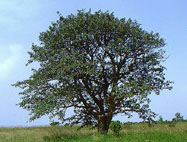
The Botanical Garden
Linnaeus had no time to make the journey to Skåne until spring 1749. One of the expedition's missions was to find out the best location to grow Walnut and Swedish Whitebeam. These woods were used to make the butts to the rifles for the military.
The student Olof Söderberg took part in the journey. Linnaeus had made his earlier journeys on horseback but this journey he made in a carriage, as he did not consider himself strong enough for such a long ride. The expedition was successful. Unlike his journey to Västergötland the weather was beautiful. They were also very well received everywhere.
Linnaeus visited Stenbrohult and his brothers and sisters on his way to Skåne. His father had died the year before. This was Linnaeus last visit in his native district. In 1750 he published his Skånska Resa.
During his time in Uppsala Linnaeus began in 1742 a thorough reconstruction of the Botanical Garden. He built an orangery, gave the garden a new division and expanded it. He got seeds from friends all over Europe. The gardener in the Botanical Garden was Didrik Nietzel, who Linnaeus had met in Holland when Nietzel was working for Clifford. Linnaeus had succeeded to persuade the capable gardener to leave Holland and move to Sweden.
Many medical plants and other species with economical value were grown in the Botanical Garden. To drink tea had become fashionable and all sorts of substitutes were tested to save the expense of the import. Linnaeus was convinced that it was possible to grow tea plants in Sweden. In 1762 he got a living tea plant from captain C. G. Ekeberg and succeeded in the summer 1765 to make it flower.
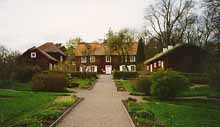
Hammarby and Sävja
Linné thought the air in Uppsala was unhealthy and the town too noisy. For that reason Linné in 1758 bought the two farms Hammarby and Sävja. The year after he also bought the neighbouring farm Edeby. Linné had to put himself in debt for these purchases. The original building at Hammarby was a small one-storey house. In consideration of his children's future Linné built a new bigger main building that was ready in 1762.
The Linnaean family spent their summers at Hammarby. There Linné could grow plants which did not tolerate the too humid soil in the Botanical Garden in Uppsala. Of the seeds Linné got from queen Katarina II of Russia, he arranged a special department in his garden called "Sibiria". At Hammarby Linné received students for private lessons.
After a big fire in Uppsala in 1766 Linné became worried about his collections and he therefore built a museum on the hill behind Hammarby for them.
Despite industrious attempt to keep Linné's collections in Sweden, the herbarium was sold to Sir James Edward Smith in London after the death of Carl fil. in 1784. The profit went to Linné's daughters. Part of the linnean herbarium had been left to Claes Alströmer as security for a loan, and were in time presented to the Royal Swedish Academy of Sciences and are still left in Sweden.
The so called "Herbarium parvum", which consisted of Linné's son's early collections and removed duplicate specimens from Linné's large herbarium, is now in the Linnean herbarium at Swedish Museum of Natural History in Stockholm.
References:
Fries, Th. M., 1903: Linné, lefnadsteckning, Fahlcrantz & Co., Stockholm.
Lindman, C. A. M., 1907: A Linnean Herbarium in the Natural History Museum in Stockholm. 1. Monandria-Tetrandia, Arkiv för Botanik, vol. 7, no. 3.
Malmeström, E. & A. H. Uggla, 1957: Vita Caroli Linnaei. Carl von Linnaeus självbiografier, Almquist & Wiksell - Stockholm.
Tillberg, T., 1907: Linnéporträtt, Almquist & Wiksell - Uppsala.
Uppsala Universitet, 1999-03-10: Linnés Hammarby, web site: http://www.hammarby.uu.se/.
Uppsala Universitet, 1999-03-10: Linnéträdgården, web site: http://www.linnaeus.uu.se/.



